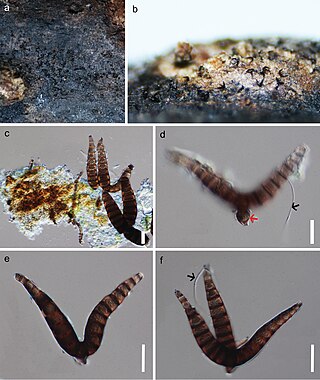Related Research Articles
Pelomonas saccharophila is a Gram-negative soil bacterium. It was originally named Pseudomonas saccharophila in 1940, but was reclassified in 2005 to the newly created genus, Pelomonas. The original strain was isolated from mud.
The Chloroflexota are a phylum of bacteria containing isolates with a diversity of phenotypes, including members that are aerobic thermophiles, which use oxygen and grow well in high temperatures; anoxygenic phototrophs, which use light for photosynthesis ; and anaerobic halorespirers, which uses halogenated organics as electron acceptors.
Nautosphaeria is a genus of fungi in the family Halosphaeriaceae. This is a monotypic genus, containing the single species Nautosphaeria cristaminuta, which was found on submerged wood.
Naïs is a genus of fungi in the family Halosphaeriaceae. The genus, which contains two species, was circumscribed by mycologist Jan Kohlmeyer in 1962 to contain Naïs inornata. N. aquatica was described from submerged wood collected in north Queensland, Australia in 1992.

Iodosphaeria is a genus of fungi in the family Amphisphaeriaceae. Most of species of Iodosphaeria are saprobes that feed on dead leaves and twigs of various hosts such as the Argentine white pine. No species have been reported as pathogenic to hosts. As of January 2022, it contains eleven species.
Leifsonia is a Gram-positive genus of bacteria from the family Microbacteriaceae.
Unisetosphaeria is a fungal genus in the family Trichosphaeriaceae. This is a monotypic genus, containing the single species Unisetosphaeria penguinoides, found on dead petioles and rhachides of the palms Eleiodoxa conferta and Nenga pumila in Sirindhorn Peat Swamp Forest, southern Thailand.

Annulatascus is a genus of fungi in the Annulatascaceae family of the Ascomycota. The relationship of this taxon to other taxa within the Sordariomycetes class is unknown, and it has not yet been placed with certainty into any order. The genus is characterized by taxa that are saprobic on submerged, decaying plant material in freshwater habitats. Morphologically the taxa possess dark brown to black perithecia, long tapering hyaline septate paraphyses, eight-spored asci with relatively massive J− apical rings, and ascospores that may or may not possess gelatinous sheaths or appendages. There are currently 17 species included in the genus.
Diluviicola is a genus of fungi in the Pseudoproboscisporaceae family and Atractosporales order, within the subclass class of Diaporthomycetidae.
The Lulworthiaceae are a family of marine fungi in the Ascomycota, class Sordariomycetes. Species in the family have a widespread distribution in both temperate and tropical oceans, and are typically found growing on submerged wood or on seaweed. In 2000, Molecular analysis of several species of Lulworthia and Lindra led to the reassignment of their parent genera to the new order Lulworthiales in addition to the new family Lulworthiaceae. In 2020, a large fungi study added more genera to the family.
Acrocalymma is a fungal genus in the family Lophiostomataceae. It was circumscribed in 1987 by Australian botanists John L. Alcorn and John Irwin to contain the species A. medicaginis, found to cause crown and root disease of alfalfa. The genus name is derived from the Ancient Greek words acros and calymma ("hood"). Acrocalymma aquatica, discovered in northern Thailand, was added to the genus in 2012.
Arcicella aquatica is a bacterium from the genus of Arcicella which has been isolated from the neuston film of a freshwater lake in Russia.
Aquatica is a genus of fireflies in the subfamily Luciolinae. The species are found in China, Taiwan, Japan, Russia and Korea. Fu, Ballantyne and Lambkin erected the genus in 2010, using phylogenetic, morphological and behavioural evidence. Its type species is Aquatica wuhana. It contains five species:
Silvanigrella is a genus of the phylum Bdellovibrionota. The genus currently contains two described species: Silvanigrella aquatica and Silvanigrella paludirubra.
Conioscypha is a genus of terrestrial and freshwater fungi in the monotypic family Conioscyphaceae and the monotypic order Conioscyphales. They are found on decayed wood, leaves, or bamboo stems. Except for Conioscypha japonica which was isolated from dog skin fragments and hair in 2017.
Conioscyphales is an order of freshwater and terrestrial fungi within the division Ascomycota. It is in the subclass Savoryellomycetidae and the class Sordariomycetes and the subdivision of Pezizomycotina.
Savoryellaceae is a family of aquatic based fungi. It is the only family in the monotypic order Savoryellales within the class Sordariomycetes, division Ascomycota.
Savoryella is a genus of freshwater and marine based fungi in the family Savoryellaceae and the order Savoryellales.
Pleurotheciaceae is a family of ascomycetous fungi within the monotypic order of Pleurotheciales in the subclass Savoryellomycetidae and within the class Sordariomycetes.
Pseudodactylaria are a genus of fungi, within the monotypic family PseudodactylariaceaeCrous, and within the monotypic order PseudodactylarialesCrous, within the class Sordariomycetes. They are saprobic on plants in freshwater or terrestrial habitats.
References
- ↑ Lumbsch TH, Huhndorf SM (December 2007). "Outline of Ascomycota – 2007". Myconet. 13: 1–58. Archived from the original on 2009-03-18. Retrieved 2015-09-23.
- ↑ Ranghoo VM, Tsui CKM, Hyde KD (2001). "Brunneosporella aquatica gen. et sp. nov., Aqualignicola hyalina gen. et sp. nov., Jobellisia viridifusca sp. nov. and Porosphaerellopsis bipolaris sp. nov. (ascomycetes) from submerged wood in freshwater habitats". Mycological Research. 105 (5): 625–633. doi:10.1017/S0953756201003793.